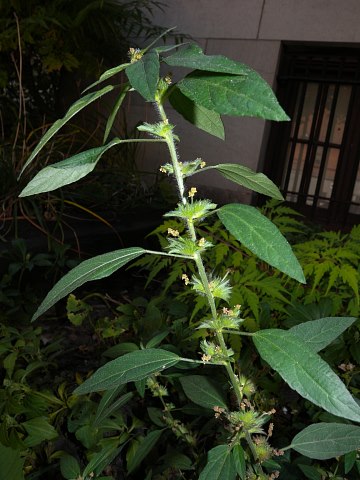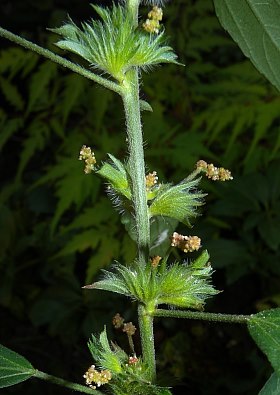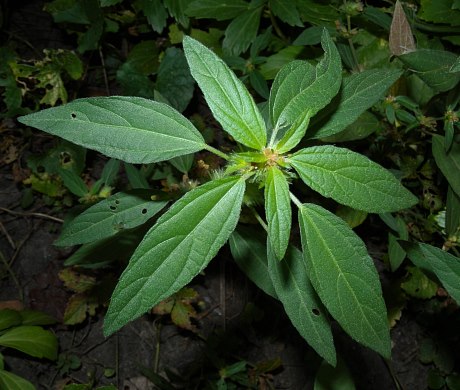Description: This plant is a summer annual about ½–2' tall that is either unbranched or occasionally branched. The stems are light to medium green, terete, and moderately covered with a combination of spreading hairs, curved hairs, and short pubescence. The alternate leaves are more closely spaced together toward the apex of the plant rather than the bottom, providing it with a flat-topped appearance. The leaf blades are up to 3" long and 1" across; they are medium green, lanceolate, and crenate with widely spaced blunt teeth to nearly smooth. The upper surfaces of the blades are sparsely canescent, sparsely covered with appressed hairs, or hairless. The slender petioles are up to 1" long; they are about one-third the length of their blades and usually short-pubescent.

Virginia Mercury
is monoecious, bearing both staminate (male) and pistillate (female)
flowers on the same plant. Both male and female flowers develop within
the same foliaceous bracts from the axils of the leaves. These bracts
are sessile (or nearly so), up to ½" tall, and a little more across;
they are either open or loosely folded around the flowers. Individual
bracts are medium green, more or less hairy, palmately lobed (10-15
lobes), and ciliate along their margins. Individual lobes are
linear-lanceolate. Within each bract, a spike of staminate flowers
develops. At maturity, each spike is up to ¾" long. Each staminate
flower is less than 1/8" (3 mm.) across, consisting of a 4-lobed calyx,
no
petals, and several stamens. The staminate flowers are densely packed
along the upper half of each spike. Within the same bract, there are
1-3 sessile pistillate flowers that are largely hidden from
view. Each pistillate
flower is about ¼" across, consisting of insignificant sepals, no
petals, and a 3-valved globoid ovary with short divided styles. The
blooming period occurs from mid-summer into the fall and lasts about
2-3 months. Only a few flowers are in bloom at the same time.
Cross-pollination is by wind. Each pistillate flower matures into a
3-celled seed capsule; each cell of the capsule contains a single
ovoid-oblongoid seed about 1-2 mm. long. This plant reproduces by
reseeding itself.
Cultivation:
The preference is partial sun, mesic conditions, and a fertile loam,
although other soil types are tolerated. Most growth and development
occurs during the summer and early fall.

Range &
Habitat:
The native Virginia Mercury is occasional to locally common in the
southern half
of Illinois, becoming uncommon in the northern half of the state (see Distribution
Map). Habitats include disturbed open woodlands, rocky
woodlands, thinly wooded bluffs, woodland borders, thickets, disturbed
areas of prairies and weedy meadows, partially-shaded gravelly seeps,
cropland and abandoned fields, areas along railroads and roadsides,
flower gardens underneath trees, and areas adjacent to the foundations
of buildings. This plant has low fidelity to any particular habitat.
Faunal Associations:
The flea beetles Hornaltica bicolorata and Margaridisa
atriventris feed on Acalypha spp. The
Mourning Dove, Swamp Sparrow, and possibly other birds eat the seeds,
while White-Tailed Deer browse on the foliage, primarily during the
summer and fall. Virginia Mercury lacks the toxic white latex that is a
typical characteristic of other species in the Spurge family
(Euphorbiaceae).
Photographic Location:
A flower garden underneath a tree in downtown Urbana, Illinois.

Comments: Virginia Mercury is somewhat weedy, although it is less aggressive and common than Acalypha rhomboidea (Rhomboid Mercury). In the past, Rhomboid Mercury and Acalypha deamii (Deam's Mercury) were considered varieties of Virginia Mercury, but they are now regarded as distinct species. Virginia Mercury differs from these latter two species by its more hairy stems, more narrow leaves, more numerous lobes (10-15) on its foliaceous bracts, and slightly longer staminate spikes that are exerted beyond the lobes of the bracts. Another species, Acalypha graciliens (Slender Mercury), has even more slender leaves than Virginia Mercury and its petioles are shorter (about one-fourth the length of its leaves). Slender Mercury usually has longer staminate spikes (at least 1" long), although there is an uncommon variety (var. monococca) that has staminate spikes about the same length as Virginia Mercury. Individual seed capsules of Acalypha graciliens var. monococca have one seed each, while seed capsules of Virginia Mercury have 3 seeds each. Another common name of Acalypha virginica is Virginia Copperleaf.